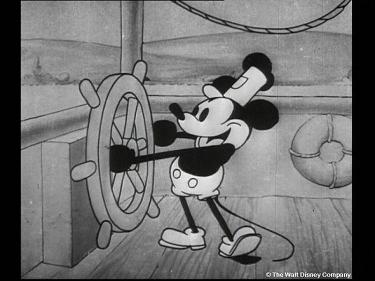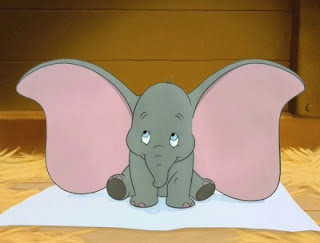Release date(s): 12/5/1941
Distributed by: Paramount Pictures
Studio:
Running time: 78 minutes
Director: Dave Fleischer
Producer: Max Fleischer
Writers: Kenny Gardner, Gwen Williams, Jack Mercer, Tedd Pierce, Carl Meyer, Stan Freed, Pauline Loth
Inspired by Maurice Maeterlinck's The Life of the Bee
Music: Leigh Harline, Frank Loesser
Country: United States
Language: English
Mr.
Bug Goes to Town, also known as Hoppity Goes to Town and Bugville, is
an animated feature produced by Fleischer Studios and released to theaters by
Paramount Pictures on December 5, 1941. It was originally meant to be an
adaptation of Maurice Maeterlinck's The
Life of the Bee, but the Fleischers were unable to get the rights to the
book, and the studio came up with its own story inspired by The Life of the Bee instead. The film was produced by Max
Fleischer and Dave Fleischer, who was credited as director. The sequences for
the film were supervised by Willard Bowsky, Shamus Culhane, H.C. Ellison,
Thomas Johnson, Graham Place, Stanley Quackenbush, David Tendlar and Myron
Waldman.
Plot:
The plot
describes the return of Hoppity the Grasshopper, after a period spent away, to
an American city. He finds that all is not as he left it, and his good insect
friends (who live in the "lowlands" just outside the garden which
belongs to a songwriter and his wife) are now under threat from the 'human
ones', who are trampling through the broken down fence which prefaces the
property, using it as a shortcut.
Insect
houses are being flattened by their feet, and are also often burned by cast
away cigar butts and matches. Old Mr. Bumble and his beautiful daughter Honey
(Hoppity's childhood sweetheart) are in grave danger of losing their Honey Shop
to this threat.
To
compound their problems, devious insect "property magnate" C. Bagley
Beetle has romantic designs on Honey Bee himself, and hopes, with the help of
his henchmen Swat the Fly and Smack the Mosquito, to force Bumble to give him
her hand in marriage.
Voice Cast:
Dick: Kenny Gardner
Mary: Gwen Williams
Mr. Bumble/Swat: Jack Mercer
C. Bagley Beetle: Ted Pierce
Smack: Carl Meyer
Hoppity: Stan Freed
Honey: Pauline Loth
The Four Marshals (Mute)
The Royal Guards (Mute)
Production:
Mr.
Bug Goes to Town was beset by problems early on. To produce their first
animated feature, Gulliver's Travels,
the Fleischers had moved their studio from New York City to Miami, Florida, and
expanded their staff, at great expense. Immediately after Gulliver was
completed and released, the studio began development on a second feature,
eventually going into production on Mr.
Bug. The studio was already deeply in debt from the expense of "Mr.
Bug" and the expensive costs of the Superman shorts which were in
production around the same time. The Fleischers were forced to sell their
studio to Paramount mid-way through production on Mr. Bug, on May 24, 1941. Paramount kept the Fleischers in
production, but they were required to deliver unsigned letters of resignation
to Paramount, to be used at the studio's discretion, as the brothers were
growing apart.
Release:
Mr. Bug was originally going to be
released in November 1941, but since the Fleischers' rival, Walt Disney
Productions, had its film Dumbo released weeks earlier in October and was
already a success, Paramount changed the date to December. Having the misfortune
of opening two days before the attack on Pearl Harbor, Mr. Bug was a financial
disaster (although having slightly positive reviews) and led to the ousting of
Max and Dave Fleischer from the studio they had established in 1919.
Paramount reorganized the company
as Famous Studios. Max and Dave had not
spoken to each other since early in 1940 due to personal and professional disputes.
Apart from this, before Mr. Bug 's release, Walter Lantz, Paul Terry and Leon
Schlesinger were considering producing animated feature films, but after
responding to the disappointing results of this film and the initial failures
of Walt Disney's other own two films Pinocchio and Fantasia, the projects were
later eventually canceled.
Paramount later re-released Mr. Bug
as Hoppity Goes to Town; the original title is a parody of the title of the
1936 film Mr. Deeds Goes to Town. The film cost $713,511 to make, and had only
made $241,000 back by 1946, the year it was withdrawn from circulation. The
film had apparently failed at the box office. Under the reissue title, Hoppity
has had multiple re-releases on home video (with inferior image quality)
throughout the 1970s to its recent DVD release by Legend Films, in which the
studio re-titled the film again to Bugville. The film has now become a cult
favorite with a younger generation of animators and animation buffs.
The film was acquired by U.M. &M.
T.V. Corp. in 1955, which was later bought out by National Telefilm Associates
(which became Republic). The film (as Hoppity Goes to Town) was officially
released by Republic Pictures on VHS and laserdisc in May 1989. While NTA
failed to renew copyrights to many of the films they acquired, Mr. Bug Goes to
Town was one of the only few films that did get its copyright renewed. Despite
the fact that the film is still copyrighted (by Republic successor Melange
Pictures, managed by parent company Viacom, which also owns Paramount
Pictures), public domain companies have released the film on VHS and DVD.
In Japan, the movie was released on
December 19, 2009 as part of Studio Ghibli's Ghibli Museum Library. A DVD was
released on April 2010 by Walt Disney Studios Home Entertainment in Japan, and
it has been reported to be a restoration of an NTA re-releases print. Recently,
Mr. Bug, along with many other Fleischer-produced cartoons (including the
Fleischers' previous film, Gulliver's Travels), was restored from the original
three-strip negatives by the UCLA Film and Television Archive. Though a few art-house
theaters have recently screened the restoration which features the original
titles, there are currently no plans to release it on DVD or Blu-ray.
On October 21, 2012, the Turner
Classic Movies channel debuted the film, transferred from an original 35mm
Technicolor release print owned by the Museum of Modern Art Department of Film,
for the first time on television in a special hosted by Robert Osborne and
Jerry Beck dedicated to rare animated films, including Gulliver's Travels,
Lotte Reiniger's The Adventures of Prince Achmed, the UPA cartoons and the
silent cartoons of 1907 to 1932 of the New York Studios.
Movie Links:














